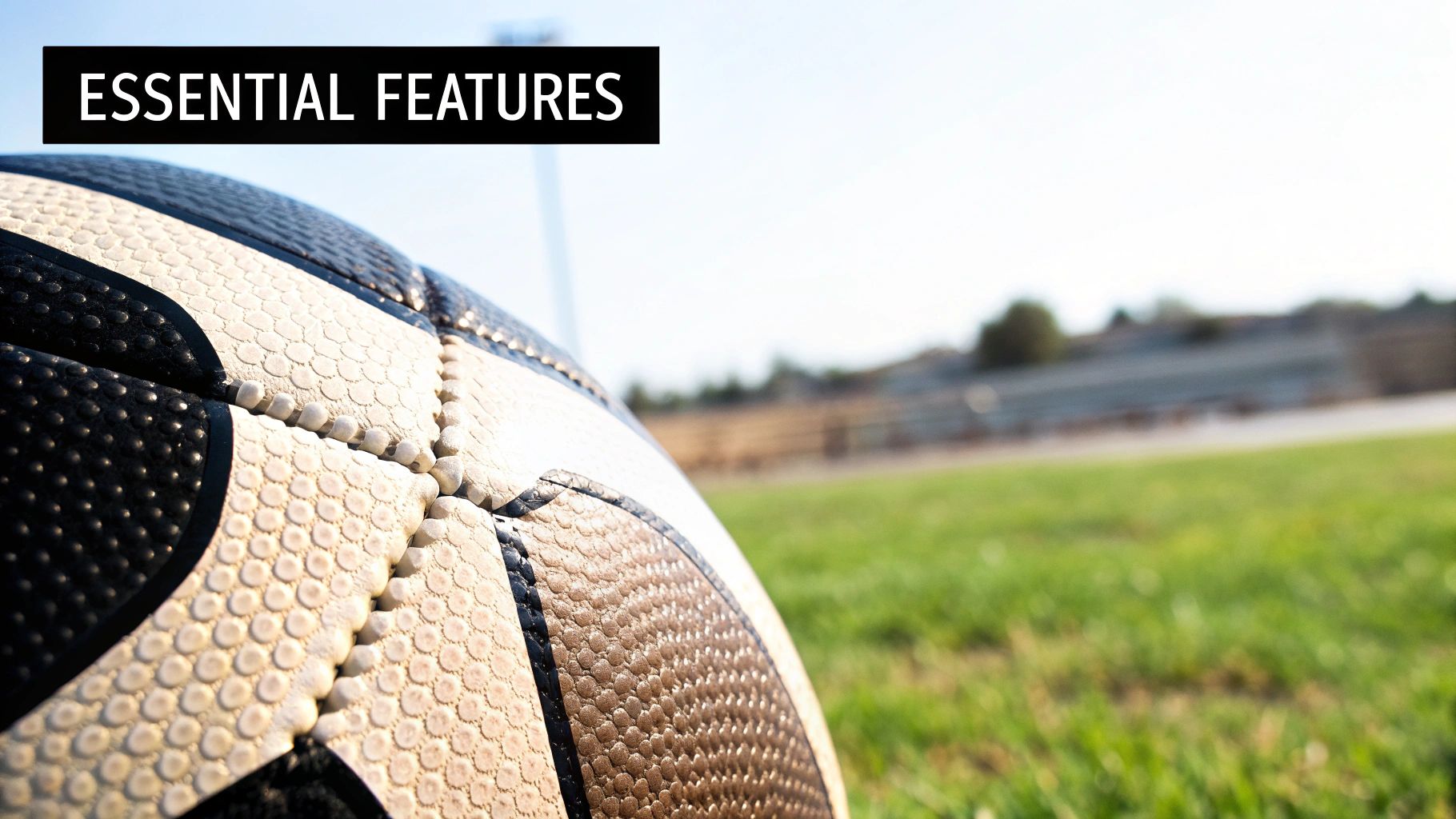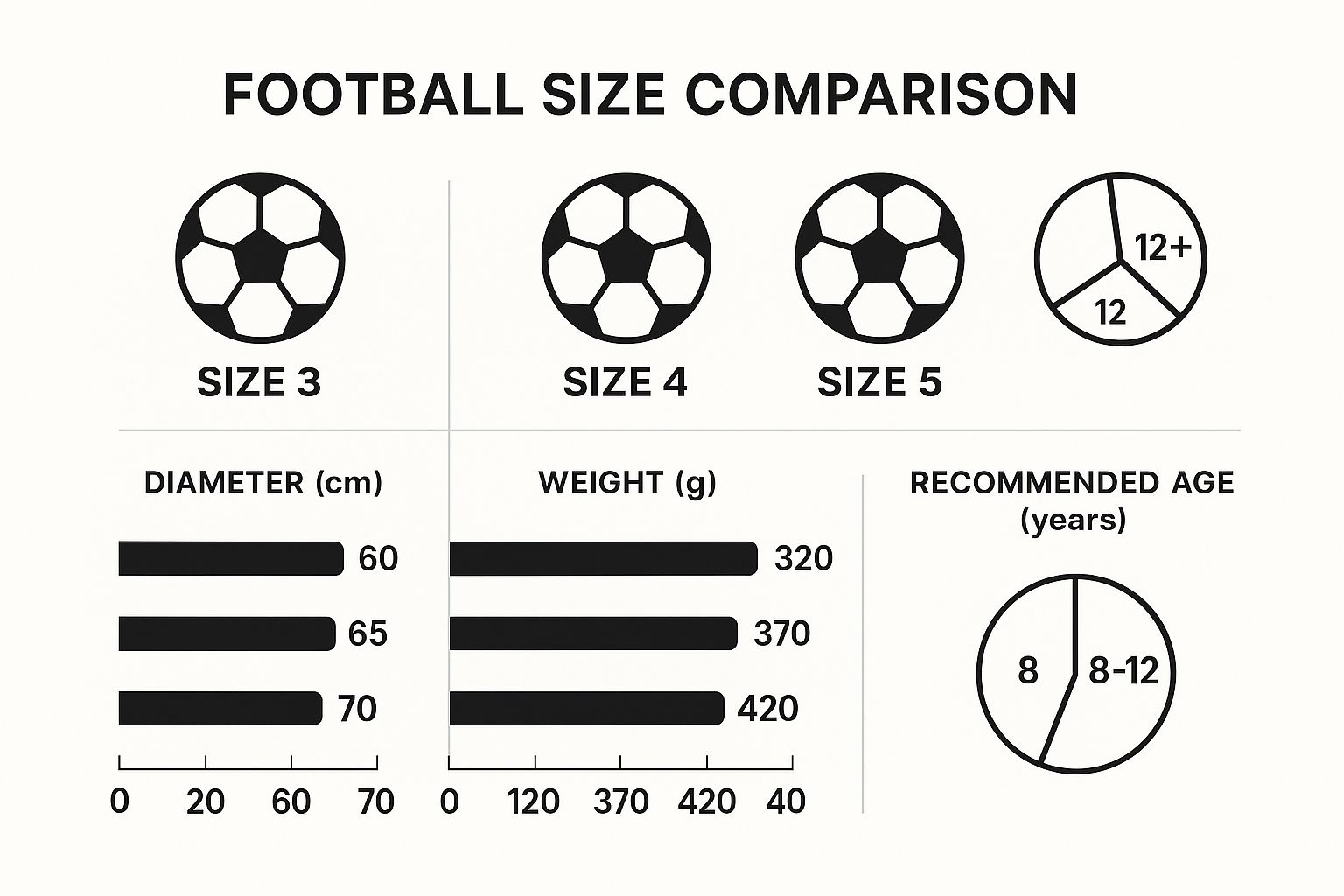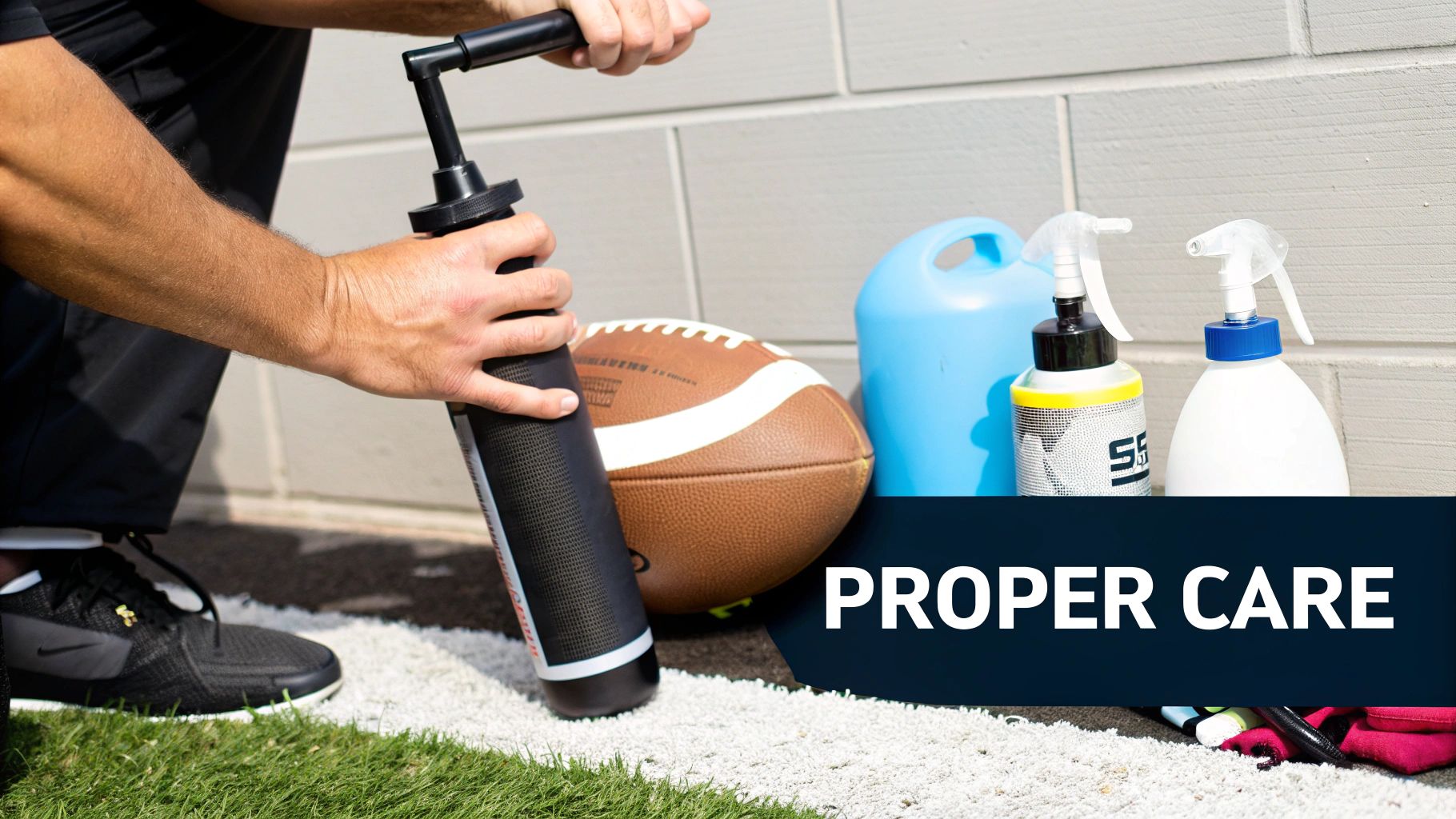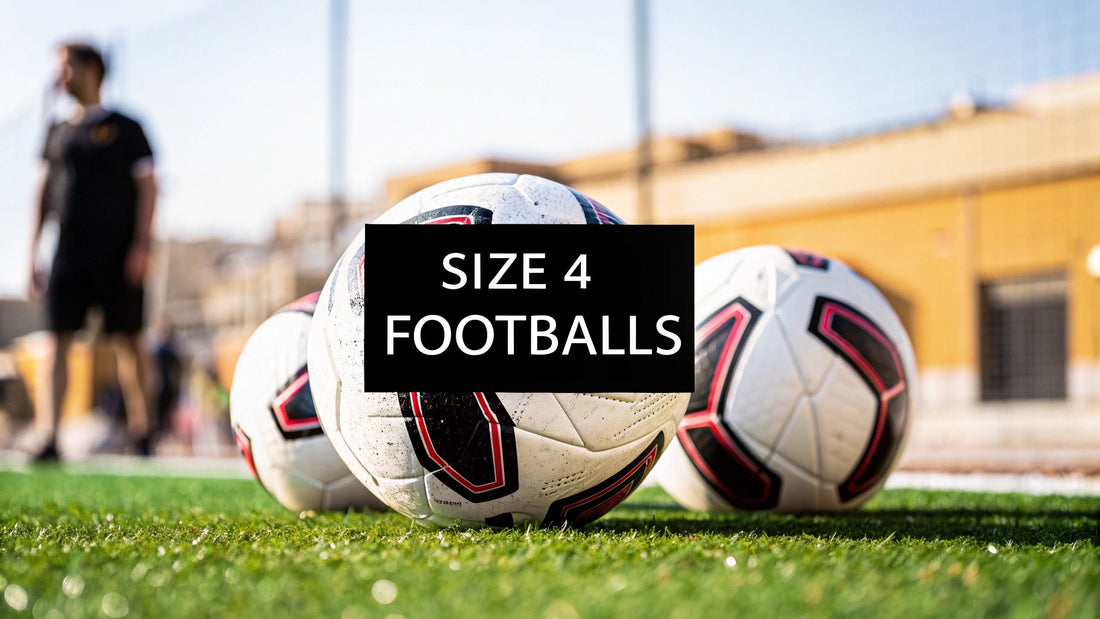For young players between the ages of 9 and 13, a size 4 football isn't just another piece of kit—it's the single most important tool for their development. It’s the perfect bridge, taking them from junior-sized balls to the full-size ones they'll use as adults. Its lighter weight and smaller circumference are specifically designed to help pre-teens build skill, not struggle.
Why a Size 4 Football Is a Game Changer for Youth Players
Think of it like learning to ride a bike. You wouldn't put a small child on a massive adult-sized bicycle and expect them to learn properly. You'd start them on one that fits, allowing them to master balance and pedalling without fear. A training football size 4 does exactly the same thing on the pitch.
It strikes the ideal balance of size and weight, letting young players focus entirely on mastering the fundamentals. When a ball is the right size, it allows for proper technique to develop naturally. Players can learn how to pass, shoot, and dribble with the correct form, generating power and control without straining their muscles or picking up bad habits.
Forcing a young player onto a size 5 ball too soon is a recipe for frustration. It can lead to clumsy technique, poor muscle memory, and ultimately, it can sap their enjoyment of the game.
Building Technique and Confidence from the Ground Up
The right equipment breeds confidence. When a young player feels in command of the ball, they're far more likely to try that tricky skill or take a creative risk. This kind of positive reinforcement is what fuels long-term passion and development.
Here’s where a size 4 ball really makes a difference:
- Better Ball Control: The smaller circumference is simply easier for smaller feet to manage, making dribbling and close control feel more natural.
- Sharper Passing: Players can wrap their foot around the ball more effectively, leading to crisper, more accurate passes.
- Proper Shooting Form: The lighter weight means they can generate power with proper follow-through instead of just kicking wildly at a heavy ball.
- More Confidence in Possession: When the ball feels like an extension of their foot, players are bolder and more willing to take on defenders.
In the UK, the size 4 is the standard training and match ball for players in the 9-13 age bracket. It's a proven step up from the size 3s used by younger children and the perfect stepping stone to the full-size 5s.
To help you get it right, here’s a quick breakdown of football sizes and their recommended age groups.
Football Size and Age Group Quick Reference
| Football Size | Recommended Age Group | Typical Use |
|---|---|---|
| Size 1 & 2 | Toddlers (Ages 1-3) | Skill balls, gifts, casual kickabouts. |
| Size 3 | Under 6 to Under 8 | First proper ball, ideal for young children's leagues. |
| Size 4 | Under 9 to Under 13 | The standard for youth development and matches. |
| Size 5 | Ages 14 and Up | Full-size ball for teens and adults, used in all official matches. |
This table is a great starting point, but always remember to check with your local league or club, as they sometimes have their own specific guidelines. Getting the size right is one of the easiest wins you can give a young player on their football journey.
What Goes Into Making a Size 4 Football?
Beyond just the size, what really separates a good training football size 4 from a bad one is its construction. How a ball is assembled has a massive impact on its durability, how it feels at your feet, and the way it behaves during a fast-paced drill. Understanding these differences is the key to picking a ball that won't let you down.
Most training balls you'll come across are machine-stitched. This is the workhorse of the football world, offering a brilliant balance of durability and affordability that makes it perfect for the demands of regular practice. The seams are tight and consistent, giving you a reliable ball that can take a beating on grass or 3G pitches.
Some of the more premium balls are hand-stitched or thermally bonded. Hand-stitching creates much deeper, tougher seams for fantastic durability, while thermal bonding gets rid of stitches altogether. This results in a perfectly round ball that absorbs very little water. You’ll usually see these on match balls, but some top-tier training models use these methods too.
The All-Important Outer Casing
Just as important as the stitching is the material used for the outer shell, or casing. This is what you actually kick, so it dictates the ball's touch, feel, and toughness.
You’ll generally find two main materials:
- Polyurethane (PU): Think of this as a high-quality synthetic leather. PU is the go-to material for decent training balls because it gives a soft touch for better control and feel. It’s also very durable and stands up well to scuffs and scrapes.
- Polyvinyl Chloride (PVC): This is your more budget-friendly option. A PVC ball is incredibly hard-wearing, which makes it great for a kickabout on rougher surfaces like concrete or playgrounds. The trade-off is that it feels harder and more plasticky, offering less of that nice, responsive feel you get from a PU ball.
For young players who are serious about their training and are out on the pitch a few times a week, a machine-stitched PU ball is the sweet spot. It's tough enough for intense sessions but has that softer, more responsive touch that’s crucial for developing skills.
So, which one should you choose? It really comes down to what you need it for. If you just want a tough ball for the park or playground, PVC will do the job. But for any kind of structured training where technique is the focus, a PU ball from a trusted brand like those at SoccerWares will give a far better performance and a much more satisfying experience.
Understanding the Role of the Football Bladder

Tucked away inside every training football size 4 is its hidden engine: the bladder. This is the component that holds the air, and its material dictates everything from how the ball feels off your foot to how often you're reaching for the pump. Think of it as the heart of the football, responsible for its bounce, shape, and overall performance.
When you're looking at different balls, you’ll find they mostly use one of two types of bladder. Knowing the difference between them is a massive help in picking a ball that truly suits your training needs.
Latex vs Butyl Bladders: A Quick Comparison
The main choice comes down to latex or butyl. Latex is the high-performance option, the one you'll find in premium match balls because it’s softer and more responsive. It gives players a much better ‘feel’ for the ball, which is brilliant for developing a delicate first touch and close control.
The only real downside to latex is that it's naturally more porous. In simple terms, it loses air much quicker than its counterpart, so you'll need to inflate it more often to keep it at the right pressure.
For consistent training sessions where reliability is key, a butyl bladder is often the superior choice. Its structure provides excellent air retention, keeping the ball firm and ready for action week after week.
Butyl bladders are the practical workhorses of the training ground. They might not offer the same super-soft touch as latex, but their ability to hold air for ages is a huge plus for coaches and parents. Less time spent fiddling with pumps means more time focused on drills.
It’s for this exact reason that the vast majority of training footballs size 4 are fitted with a durable butyl bladder. It just makes sense for a ball that needs to be ready to go, session after session. You can explore a variety of reliable training balls over at SoccerWares.
How to Choose the Perfect Size 4 Training Football
Picking the right training footballs size 4 can feel like a minefield, but it really just comes down to matching the ball to your needs. Get a few key things right, and you'll have a ball that performs well, lasts ages, and gives you great value.
Let’s break it down.
First up, where are you playing? A ball made for a lush grass pitch won’t last five minutes on an abrasive astroturf surface. If you’re regularly training on artificial turf, you’ll want a durable, machine-stitched PU ball. It's built to handle that extra friction.
Next, how often are you training? A player having a kickabout once a week has very different needs to an academy player training three or four times a week. The more intense the use, the more robust the ball needs to be. Look for one with a reliable butyl bladder—it holds air brilliantly and saves you from constantly reaching for the pump.
Key Factors for Your Checklist
Before you buy, run through this quick checklist. It will help you narrow down the options and find the perfect ball.
- Playing Surface: Is it mostly grass, 3G/4G astroturf, or an indoor court? Tougher surfaces demand tougher materials, like a hard-wearing PU or even a PVC casing.
- Training Intensity: How often will it be used? For daily or near-daily use, you need to prioritise durability and air retention. A machine-stitched ball with a butyl bladder is your workhorse.
- Player Focus: Is the training all about skill work or just general play? To really refine touch and control, a hand-stitched ball with a softer PU casing gives a much better feel, closer to a proper match ball.
- Budget: It’s tempting to grab the cheapest option, but investing a little more in a quality training ball often saves you money in the long run. It will simply last longer.
This simple graphic below shows you exactly where a size 4 fits in compared to other football sizes.

As you can see, a size 4 is a big step up from a size 3 without being as heavy or large as a full-size professional ball. For a much deeper dive, check out our complete guide to size 4 footballs over on the blog.
Comparing Size 4 Football Features for Different Needs
To make it even easier, this table breaks down which features are best suited for different situations. Use it to find the perfect match for your training setup.
| Feature | Best For Casual Play | Best For Club Training | Key Consideration |
|---|---|---|---|
| Casing Material | PVC or basic PU | High-grade PU | PU offers a softer touch and better feel, while PVC is all about durability and cost. |
| Stitching | Machine-stitched | Hand-stitched or machine-stitched | Hand-stitching gives a premium feel for skill work; machine-stitching is a durable all-rounder. |
| Bladder | Latex | Butyl | Butyl bladders hold their air much longer, making them perfect for regular, serious training. |
| Durability | Standard | High | Look for reinforced panels and abrasion-resistant casings for frequent use on tough surfaces. |
Ultimately, the best ball is the one that fits how you train. A youth team on a 3G pitch needs a different ball than a player practising skills in their back garden.
Real-World Example: A youth team that trains twice a week on a 3G pitch would be best off with a machine-stitched PU ball that has a butyl bladder. This combination offers the toughness needed for the surface, consistent performance for drills, and fantastic air retention, making it a reliable workhorse for any coach.
Simple Tips to Extend Your Football's Lifespan
A quality training football size 4 is an investment in a player’s development. Like any good tool, a little bit of care goes a long way in making it last and perform at its best. Trust me, these simple habits make a massive difference.
Proper inflation is probably the most important thing you can do. Always check the manufacturer's recommended pressure, which is usually printed right next to the valve (e.g., 8-10 PSI or 0.6-0.8 bar). Get a pressure gauge to get it spot on—over-inflating puts a huge strain on the seams, while an under-inflated ball just won't fly or bounce correctly.
Correct Inflation and Cleaning
Here's a pro tip to protect the valve from damage: always moisten the pump needle slightly before you insert it. It’s a tiny step, but it stops you from creating small tears that turn into those slow, frustrating leaks over time.
Cleaning and storing the ball properly are just as important. After a wet or muddy session, just take a minute to wipe the football down with a damp cloth. This stops dirt and grit from working their way into the outer material and degrading it.
Storing your ball correctly is one of the easiest ways to prevent premature wear. Keep it in a cool, dry place away from direct sunlight or extreme temperatures, like the boot of a hot car or a freezing shed. This simple habit prevents the casing from cracking and warping.
By following these straightforward tips, you'll keep the ball in top condition for much, much longer. For a full rundown of other essential gear, check out our guide to the best football training equipment and make sure your player is ready for every session.
Still Got Questions About Size 4 Footballs?

Let's wrap things up by tackling some of the most common questions we hear from parents and coaches about training footballs size 4. Getting straight answers helps you pick the right ball and gives your young player the best chance to develop their skills and, most importantly, have fun.
These are the practical queries that often pop up right before you hit 'buy', so we've gathered the essentials for you right here.
Can My 8-Year-Old Use a Size 4 Football?
Honestly, it’s a bit of a stretch. While an 8-year-old could technically kick a size 4 ball around, a size 3 is still the recommended tool for the job for players aged 6-8. A size 3 is lighter and smaller, making it far easier for them to build confidence and master the basics without struggling against a ball that's too big or heavy.
The jump to a size 4 is best made around age 9. By then, a player’s strength, coordination, and technique are usually ready for the step up. Sticking to the proper ball progression is one of the simplest ways to support a young player's development.
Is There a Real Difference Between a Match Ball and a Training Ball?
Yes, a huge one! Match balls are high-performance models, built with top-tier materials and often using advanced techniques like thermal bonding to ensure a perfect flight path. This makes them pricier and less suited for the daily grind of practice.
Training balls, on the other hand, are the workhorses. They're built for durability, often with machine-stitching and tougher outer materials that can take a beating on all sorts of surfaces. For regular sessions, a dedicated training football size 4 is easily the more practical and cost-effective choice.
Think of it like running shoes. You have your lightweight, super-responsive racing shoes for competition day, but you log most of your miles in durable, supportive trainers. Both are essential, but they’re built for different jobs.
How Do I Know the Right Pressure for My Size 4 Football?
This one’s easy. The recommended inflation pressure is almost always printed right on the football itself, usually near the valve. It will be shown as a range, something like 0.6-0.8 BAR or 8-10 PSI.
It's really important to use a pressure gauge and stick to that range. Over-inflating can stress the seams and permanently damage the ball, while under-inflating completely messes with its bounce and flight. An improperly inflated ball can really hold a player back.
Ready to find the perfect training ball to help your young star shine? Explore the high-quality collection at SoccerWares and discover the ideal option to support their football journey.

